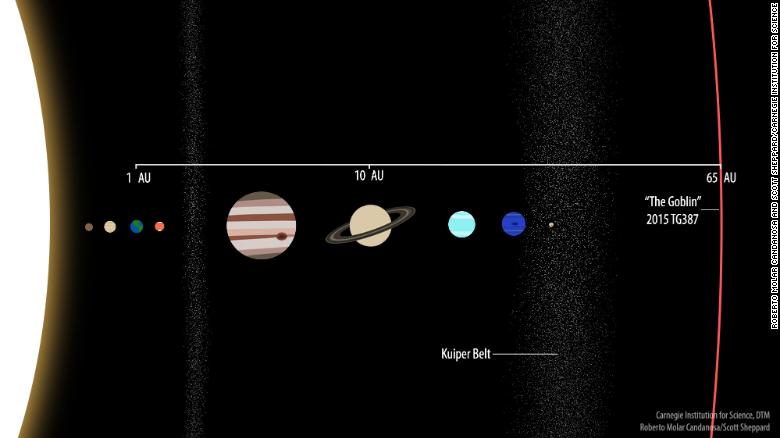While searching for the mysterious Planet X that some astronomers believe lurks on the edge of our solar system, researchers instead found an extremely distant object they dubbed "the Goblin." And this object provides compelling evidence for the existence of Planet X.
The object is on the small end of being a dwarf planet, with a 40,000-year orbit -- meaning it takes that long to go around the sun. That's more than 2,000 times the distance between the Earth and the sun. Its current location is about 2½ times farther from the sun than from Pluto.
"I think we are nearing the 90% likelihood of Planet X being real with this discovery," said Scott Sheppard, an astronomer at the Carnegie Institution for Science.
The Goblin got its nickname because the scientists first observed it around Halloween 2015. It is considered an Inner Oort Cloud object. The Oort Cloud is a predicted bubble around our solar system far beyond Pluto, filled with trillions of icy bodies and the supposed birthplace of long-term comets.
The International Astronomical Union's Minor Planet Center announced the object, formally known as 2015 TG387, on Tuesday. The researchers, including Sheppard, Northern Arizona University's Chad Trujilllo and the University of Hawaii's David Tholen, have also submitted a paper to the Astronomical Journal detailing their findings.
 .
.So if the Goblin is unaffected by the gas giant planets in our solar system, what contributes to its strange orbit? That's where Planet X comes in.
Like the other objects found by Sheppard and his team on the edge of the solar system, the Goblin behaves in a way that is pushed into a similar orbit by some unseen force.
Based on simulations using the basic parameters they have for Planet X, the researchers say the Goblin acts like it is "shepherded" by the planet but never nears the proposed massive planet. This is similar to why Pluto never gets too close to the gas giant Neptune, although their orbits actually cross.
"These distant objects are like breadcrumbs leading us to Planet X," Sheppard said. "The more of them we can find, the better we can understand the outer Solar System and the possible planet that we think is shaping their orbits -- a discovery that would redefine our knowledge of the Solar System's evolution."Sheppard and his colleagues continue their survey, the largest and deepest ever for distant solar system objects, by observing the northern and southern skies at all times of year.
"We are very uniform in our sky coverage and can find all types of orbits, yet we seem to only be finding objects with similar types of orbits that are on the same side of the sky, suggesting something is shepherding them into these similar types of orbits, which we believe is Planet X," Sheppard said."What makes this result really interesting is that Planet X seems to affect 2015 TG387 the same way as all the other extremely distant Solar System objects. These simulations do not prove that there's another massive planet in our Solar System, but they are further evidence that something big could be out there," Trujillo said in a statement.

















-190903103849079.jpg)





